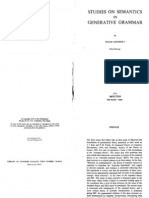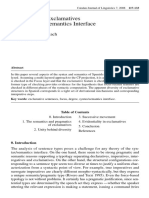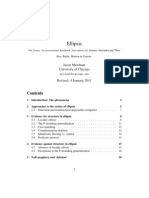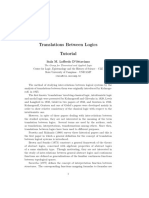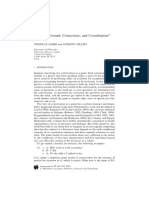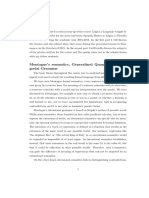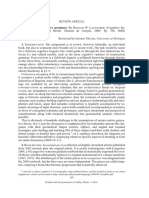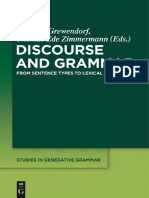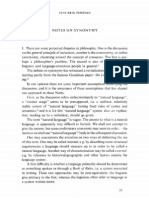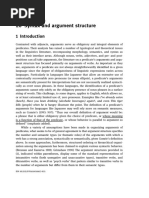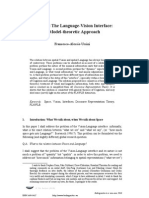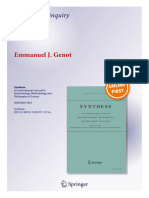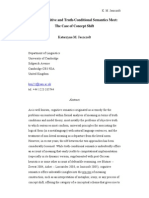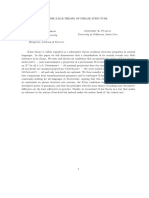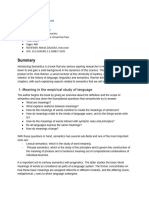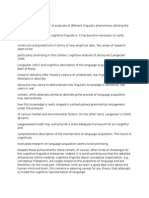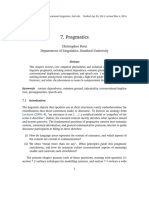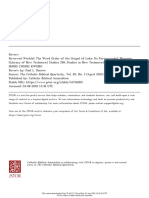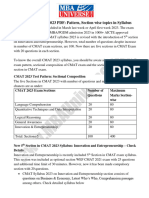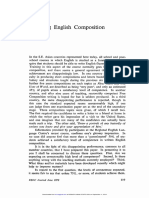Hintikka Chapter On. Semantic Meaning
Hintikka Chapter On. Semantic Meaning
Uploaded by
Chaudhuri MitaliCopyright:
Available Formats
Hintikka Chapter On. Semantic Meaning
Hintikka Chapter On. Semantic Meaning
Uploaded by
Chaudhuri MitaliOriginal Title
Copyright
Available Formats
Share this document
Did you find this document useful?
Is this content inappropriate?
Copyright:
Available Formats
Hintikka Chapter On. Semantic Meaning
Hintikka Chapter On. Semantic Meaning
Uploaded by
Chaudhuri MitaliCopyright:
Available Formats
J A AKKO H INTI KKA
Q U ANTI FIE RS VS. O U ANTI FI CAT ION THE O RY
The syntax and semantics of quantifiers is of crucial significance in
current linguistic theorizing for more than one reason. The last state-
ment of his grammatical theories by the late Richard Montague (1973)
is modestly entitled ‘The Proper Treatment of Quantification in Ordi-
nary English’. In the authoritative statement of his ‘Generative Seman-
tics’, George Lakoff (1971, especially pp. 238—267) uses as his first and
foremost testing-ground the grammar of certain English quantifiers. In
particular, they serve to illustrate, and show need of, his use of global
constraints governing the derivation of English sentences. Evidence
from the behavior of quantifiers (including numerical expressions l) has
likewise played a major role in recent discussions of such vital prob-
lems as the alleged meaning-preservation of transformations,° co-
reference,° the role of surface structure in semantical interpretation,^
and so on.
In all these problems, the behavior of natural-language quantifiers is
one of the main issues. Ouantifiers have nevertheless entered the
Methodenstreit of contemporary linguistics in another major way, too.
(These two groups of problems are of course interrelated.) This is the
idea that the structures studied in the so-called quantification theory of
symbolic logic — otherwise known as first-order logic, (lower)
predicate calculus, or elementary logic — can serve and suffice’ as
semantical representations of English sentences. Views of this general
type have been proposed by McCawley (1971)‘ and Lakoff (1972) 7
(among others). A related theory of ‘Deep Structure as Logical Form’
has been put forward and defended by G. Harman (1972). Theories of
this general type may be compared with the traditional idea that
quantifica- tion theory can be viewed as an abstraction from the
behavior of natural-language quantifiers (as a representation of their
‘logical form") and with W. V. Ouine's (1960) view of quantification
theory as the ‘canonical notation’ of all scientific discourse. It is not
clear precisely how much is gained or lost linguistically according to
these last two types of views in the transition from ordinary discourse
to the language of first-order logic, but obviously some sufficiently loose
‘congruence of meaning’ is being assumed.
49
2S. Saarinen (ed.), Game -Theoretical Semantics, 49—79. All Rights Heseroed.
Copynght @ 1974 by DIALS MCA and The Mossnciiusetts Institute o{ Technology.
50 JAAKKOHINI]KKA
It will be shown in this paper that these views are seriously inade-
quate as they are usually formulated. (I shall not examine whether, and
if so how, they can perhaps be repaired.) For this purpose, I will first
sketch a more satisfactory semantical theory of certain English quan-
tifiers, viz. those corresponding most closely to logicians’ familiar
universal quantifier and existential quantifier.' O I shall indicate the
range of problems that can apparently be dealt with by means of this
theory, and go on to show how it naturally leads us to consider certain
English quantifier expressions whose semantical representations go
beyond first-order logic and hence are beyond the purview of the
competing theories just mentioned. Indeed, we obtain in this way
interesting specific results concerning the logical strength of quantifica-
tion in English as compared with various kinds of logical systems.
Finally, these results will prompt certain conjectures concerning the
methodological asymmetry of syntax and semantics.
The semantics of English quantifiers I am about to sketch is formu-
lated in terms borrowed from the mathematical theory of games, and
might be referred to as game-theoretical semantics. (For the basic
ideas of game theory, see e.g. Luce and Raiffa, 1957 or Davis, 1970.)
The concepts involved are so straightforward, however, that they can
be appreciated without any knowledge of game theory. This theory is a
direct analogue to a corresponding game-theoretical semantics for
formal (but interpreted) first-order languages, sketched in Hintikka
(1968a) and (1973, Ch. 3)." Its leading ideas can perhaps be best seen
from this somewhat simpler case, which I will therefore first outline
briefly.
Let's assume we are dealing with a language with a finite list of
predicates (properties and relations). That we are dealing with an
interpreted language means that some (non-empty) domain D of
entities, logicians’ ‘individuals’, has been given and that all our predi-
cates have been interpreted on D. This interpretation means that the
extentions of our predicates on D are specified. This specification in
turn implies that each atomic sentence, i.e., sentence in which one of
our n-place predicates is said to apply to an n-tuple (sequence) of
individuals, has a determinate truth-value, true or false. In a sense,
what we are doing here is to extend this definition of truth to all the
other (first-order) sentences. They are obtained from atomic sentences
by propositional operations, for instance, by applying (negation),
(conjunction), and ‘v’ (disjunction),i2 and/or by applying existential
or universal generalization, i.e., by replacing a number of occurrences
You might also like
- Chomsky - Studies On Semantics in Generative GrammarDocument103 pagesChomsky - Studies On Semantics in Generative Grammardharmavid100% (2)
- Logic and Philosophy of Logic: Recent Trends in Latin America and SpainDocument307 pagesLogic and Philosophy of Logic: Recent Trends in Latin America and SpainAbilio Rodrigues100% (1)
- Noam-chomsky-The Cartography of Syntactic StructuresDocument17 pagesNoam-chomsky-The Cartography of Syntactic StructuresnanokoolNo ratings yet
- Logical Form in LinguisticsDocument3 pagesLogical Form in LinguisticsDanielNo ratings yet
- Hintikka Jaakko 1973 Quantifiers Vs Quantification Theory DialecticaDocument30 pagesHintikka Jaakko 1973 Quantifiers Vs Quantification Theory DialecticaBankingLinguisticCheckmatesNo ratings yet
- J Van Bentham - Invariance and Definability - Two Faces of Logical Constants - in W. Sieg, R. Sommer, & C. Talcott, Eds., Ed.,.PsDocument25 pagesJ Van Bentham - Invariance and Definability - Two Faces of Logical Constants - in W. Sieg, R. Sommer, & C. Talcott, Eds., Ed.,.PsCholo MercadoNo ratings yet
- Article: "Thematic Roles Are Not Semantic Roles" Jan G. Van VoorstDocument16 pagesArticle: "Thematic Roles Are Not Semantic Roles" Jan G. Van VoorstEbinabo EriakumaNo ratings yet
- Journal of Philosophical Logic 27: 553-568, 1998Document16 pagesJournal of Philosophical Logic 27: 553-568, 1998romulolelisNo ratings yet
- 1997 Glenberg What Memory Is ForDocument55 pages1997 Glenberg What Memory Is ForJoseNo ratings yet
- SemanticsandsyntaxDocument14 pagesSemanticsandsyntaxstephenaledare1No ratings yet
- BAKER - Thematic Roles and Syntactic StructureDocument66 pagesBAKER - Thematic Roles and Syntactic StructureRerisson Cavalcante100% (1)
- Logical Constants How To Pre Final VersionDocument24 pagesLogical Constants How To Pre Final VersionNicolas Agustín Moyano LozaNo ratings yet
- 134-Article Text-287-1-10-20131214Document17 pages134-Article Text-287-1-10-20131214nucleomexico.redalfNo ratings yet
- An Introduction To Cognitive Grammar - LangackerDocument40 pagesAn Introduction To Cognitive Grammar - LangackerJesse De Sousa MouraoNo ratings yet
- Cognitive GrammarDocument40 pagesCognitive GrammarSiti Nur Najmin Aminuddin100% (2)
- Ellipsis: Jason Merchant University of ChicagoDocument43 pagesEllipsis: Jason Merchant University of ChicagoHelena BaudelaireNo ratings yet
- Itala D'Ottavianno - Translations Between LogicsDocument6 pagesItala D'Ottavianno - Translations Between LogicsKherian GracherNo ratings yet
- Count-Mass Distinction Across LanguagesDocument95 pagesCount-Mass Distinction Across LanguagesHenrique dos SantosNo ratings yet
- Archi Minimalist ChapterDocument63 pagesArchi Minimalist ChapterAlNo ratings yet
- Common GroundDocument32 pagesCommon GroundmarcelolimaguerraNo ratings yet
- The Pragmatic Interpretation of Utterances: 1 Meaning: Semantics Versus PragmaticsDocument14 pagesThe Pragmatic Interpretation of Utterances: 1 Meaning: Semantics Versus Pragmaticsمحمد سعدNo ratings yet
- Holism, Conceptual-Role Semantics, and Syntactic Semantics: Minds and Machines February 2002Document51 pagesHolism, Conceptual-Role Semantics, and Syntactic Semantics: Minds and Machines February 2002LuisNo ratings yet
- Pavlovic 2012Document10 pagesPavlovic 2012zehui guoNo ratings yet
- Montague's Semantics, Generalized Quantifiers, Cate-Gorial GrammarDocument5 pagesMontague's Semantics, Generalized Quantifiers, Cate-Gorial GrammarRebecca CacioliNo ratings yet
- Admin,+hermes 5 6 NølkeDocument28 pagesAdmin,+hermes 5 6 NølkejoseNo ratings yet
- Investigations in Cognitive GrammarDocument8 pagesInvestigations in Cognitive GrammarrioNo ratings yet
- Discourse and Grammar From Sentence Types To Lexical Categories PDFDocument349 pagesDiscourse and Grammar From Sentence Types To Lexical Categories PDFbeware111100% (2)
- Jens Erik Fenstad - Notes On SynonymyDocument43 pagesJens Erik Fenstad - Notes On SynonymyScintaNo ratings yet
- Jackendoff - Parts and Boundaries (1991)Document37 pagesJackendoff - Parts and Boundaries (1991)Juan Federico Serafini JunyentNo ratings yet
- Compound Nouns Do Not Always Fulfill The Conjunction ThesisDocument13 pagesCompound Nouns Do Not Always Fulfill The Conjunction ThesissantospintosamileNo ratings yet
- Tsujimura - Chapter - 20 - Syntax and Argument StructureDocument32 pagesTsujimura - Chapter - 20 - Syntax and Argument StructuressiebenNo ratings yet
- Dowtz Thematic Proto-Roles and Argument SelectionDocument74 pagesDowtz Thematic Proto-Roles and Argument Selectionanna czereszkoNo ratings yet
- Space and The Language-Vision Interface: A Model-Theoretic ApproachDocument52 pagesSpace and The Language-Vision Interface: A Model-Theoretic ApproachFrancesco-Alessio UrsiniNo ratings yet
- (Linguistic Inquiry Monographs) Alec Marantz-On The Nature of Grammatical Relations (Linguistic Inquiry Monographs, 10) - The MIT Press (1984)Document355 pages(Linguistic Inquiry Monographs) Alec Marantz-On The Nature of Grammatical Relations (Linguistic Inquiry Monographs, 10) - The MIT Press (1984)Janayna CarvalhoNo ratings yet
- Compositionality and Coercion in Semantics: The Dynamics of Adjective MeaningDocument17 pagesCompositionality and Coercion in Semantics: The Dynamics of Adjective Meaninggaziabra4No ratings yet
- Shifting Variation - Érica. García (1985)Document36 pagesShifting Variation - Érica. García (1985)Olga Roxana RiscoNo ratings yet
- Strategies of Inquiry The SHerlock HolmeDocument26 pagesStrategies of Inquiry The SHerlock HolmeesraxozkNo ratings yet
- Where Cognitive and Truth-Conditional Semantics Meet: The Case of Concept ShiftDocument31 pagesWhere Cognitive and Truth-Conditional Semantics Meet: The Case of Concept ShiftDifa DianNo ratings yet
- X Bar TheoryDocument24 pagesX Bar Theorystandbynick_6481851850% (2)
- Solving Logic Puzzles: From Robust Processing To Precise SemanticsDocument8 pagesSolving Logic Puzzles: From Robust Processing To Precise SemanticsRafiz SarkerNo ratings yet
- UyweDocument24 pagesUyweCardial KaplanskyNo ratings yet
- LEPWIL.1Document39 pagesLEPWIL.1eiwhnspitzNo ratings yet
- RecursionDocument19 pagesRecursionjipsykalonjiNo ratings yet
- On Tagmemics TheoryDocument15 pagesOn Tagmemics TheoryJ. Lapid100% (4)
- Review of Introducing Semantics BookDocument15 pagesReview of Introducing Semantics BookitsmeaksaniNo ratings yet
- Philosophy of LanguageDocument6 pagesPhilosophy of LanguageHind SabahNo ratings yet
- Functional Discourse Analysis PDFDocument20 pagesFunctional Discourse Analysis PDFalamirizaidNo ratings yet
- Examination of The Axiomatic Foundations IDocument14 pagesExamination of The Axiomatic Foundations ImacucorumNo ratings yet
- Higher Order MetametaphysicsDocument32 pagesHigher Order MetametaphysicstonyNo ratings yet
- Preguntas Análisis Del DiscursoDocument9 pagesPreguntas Análisis Del DiscursoLaura Gabardino SánchezNo ratings yet
- Benom, C. (2015) - Polysemy and English THROUGHDocument83 pagesBenom, C. (2015) - Polysemy and English THROUGHAnna DabrowskaNo ratings yet
- ConclusionDocument3 pagesConclusionIonut TomaNo ratings yet
- From The Spatial To The Non-SpatialDocument34 pagesFrom The Spatial To The Non-SpatialthangdaotaoNo ratings yet
- Potts Pragmatics OupcomplingDocument27 pagesPotts Pragmatics OupcomplingMedian Najma FikriyahNo ratings yet
- 10 2307@4177996 PDFDocument81 pages10 2307@4177996 PDFYuri PotiNo ratings yet
- Review of Functional and Systemic LinguiDocument9 pagesReview of Functional and Systemic Linguicrusadersam1No ratings yet
- Rizzi (2013)Document4 pagesRizzi (2013)cristinaNo ratings yet
- LESSON PLAN - Grade 3, Unit 8B - Abracadabra!Document7 pagesLESSON PLAN - Grade 3, Unit 8B - Abracadabra!Razvan TabacariuNo ratings yet
- Catholic Biblical Association The Catholic Biblical QuarterlyDocument3 pagesCatholic Biblical Association The Catholic Biblical QuarterlyMichail ChatziasemidisNo ratings yet
- DegreeDocument4 pagesDegreePravin MateNo ratings yet
- Final Term Test Paper For The 5 FormDocument2 pagesFinal Term Test Paper For The 5 FormJaneNo ratings yet
- Modal Verbs: Before You StartDocument1 pageModal Verbs: Before You StartJuliaNo ratings yet
- English Syntax For Russian Speaking StudentsDocument11 pagesEnglish Syntax For Russian Speaking StudentsDinara İbrahim QızıNo ratings yet
- UG-General English and UG-Modern Language (English Literature)Document33 pagesUG-General English and UG-Modern Language (English Literature)Vinay KiranNo ratings yet
- 272634day - 3 Vocabulary PDF - CrwillDocument4 pages272634day - 3 Vocabulary PDF - CrwillBaburam YadavNo ratings yet
- Vocabulary 001Document3 pagesVocabulary 001MM NabeelNo ratings yet
- MAKE A COPY OF THE DOC - Harvard CV TemplateDocument1 pageMAKE A COPY OF THE DOC - Harvard CV TemplateljtajnxwztiijidattNo ratings yet
- العامية المصريةDocument171 pagesالعامية المصريةhadeer hosnyNo ratings yet
- Y4 Writing ToolkitsDocument3 pagesY4 Writing ToolkitsMylie RobertsNo ratings yet
- GR 5 Lesson 2 - PrefixesDocument37 pagesGR 5 Lesson 2 - PrefixesJaeza Mae NapizaNo ratings yet
- Şcoala Gimnazială Porumbeşti Anul Şcolar 2020-2021Document5 pagesŞcoala Gimnazială Porumbeşti Anul Şcolar 2020-2021danescu elenaNo ratings yet
- Cmat Syllabus PDF 2023 - 0Document6 pagesCmat Syllabus PDF 2023 - 0amanNo ratings yet
- The Direct Method: Best To All! Waleed AlsultaniDocument2 pagesThe Direct Method: Best To All! Waleed AlsultaniAthlam AthlamNo ratings yet
- English Lesson PlanDocument7 pagesEnglish Lesson PlanJan Lemuel Fortaleza RefuncionNo ratings yet
- 7° ENGLISH GUIDE 1st TrimesterDocument4 pages7° ENGLISH GUIDE 1st TrimesterLiliana MadridNo ratings yet
- Assignment 2B TEKS - ELPS Nadean KhedrDocument2 pagesAssignment 2B TEKS - ELPS Nadean KhedrNadean KhedrNo ratings yet
- 12 Faeza Adnan Salih 01437Document7 pages12 Faeza Adnan Salih 01437el mokhtar JalalNo ratings yet
- Present and Past Simple PassiveDocument3 pagesPresent and Past Simple Passivejohn pinderNo ratings yet
- Romanian Language CourseDocument35 pagesRomanian Language CourseAntal MonalysaNo ratings yet
- CAE - Class 1Document5 pagesCAE - Class 1English 21No ratings yet
- Grammar Unit 2: Present Simple: Affirmative and Negative Present Simple: Questions and Short AnswersDocument2 pagesGrammar Unit 2: Present Simple: Affirmative and Negative Present Simple: Questions and Short Answersnuria escola hernandezNo ratings yet
- Parts of Speech Quiz 1 With AnswersDocument15 pagesParts of Speech Quiz 1 With Answerssalahwael374No ratings yet
- Lamas Fernández, ClaudiaDocument71 pagesLamas Fernández, ClaudiaClaudia Lamas FernándezNo ratings yet
- Ағылшын 1 Тоқсан 3 Сынып - 1712840417Document50 pagesАғылшын 1 Тоқсан 3 Сынып - 1712840417Нурила ҚапарNo ratings yet
- Teaching: English CompositionDocument8 pagesTeaching: English CompositionKaba ruphinNo ratings yet
- Sample of ELT Research ProposalDocument8 pagesSample of ELT Research ProposalLucio KachingongoNo ratings yet
- Anexo 1 - Task 2 - English Is Easy and Fun. Writing Task.Document24 pagesAnexo 1 - Task 2 - English Is Easy and Fun. Writing Task.Luzdy PiedrahitaNo ratings yet
